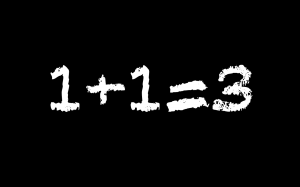Collaboration Arithmetic
Recently I have been working a lot with one of my colleagues at my university.
A lot of the time, working with others is a drag on effectiveness. Things take longer to get done, you need to agree on what to do, people don’t do their share. It tends to be 1+1 ends up being less than two, and for every person you add to the mix the final number gets lower and lower. After a certain point the results drop to zero.
However, once in a while you end up with a team that works. Synergy occurs as your complementary skill sets allow you to do things that you couldn’t do by yourself.
In that rare situation, 1+1 ends up being 3 or 4 or 5.
We have a new project in the works, and I think you will like it. More details in 2014.
In the meantime, if you don’t have a copy of our ER Program Design Manual, why not order a free copy from our Center for Professional Development?
Have you ever had a synergistic collaboration?
Not sure. I don’t think so. How do you mean?
7 – 21
8 – 28
9 – 36
10 – 45
11 – 55
12 –

There is also the arithmetic of communication. Try and figure this one out, Ben. In it’s simplest form it goes like this:
1 – 0
2 – 1
3 – 3
4 – 6
5 – 10
6 – 15
7 – ?